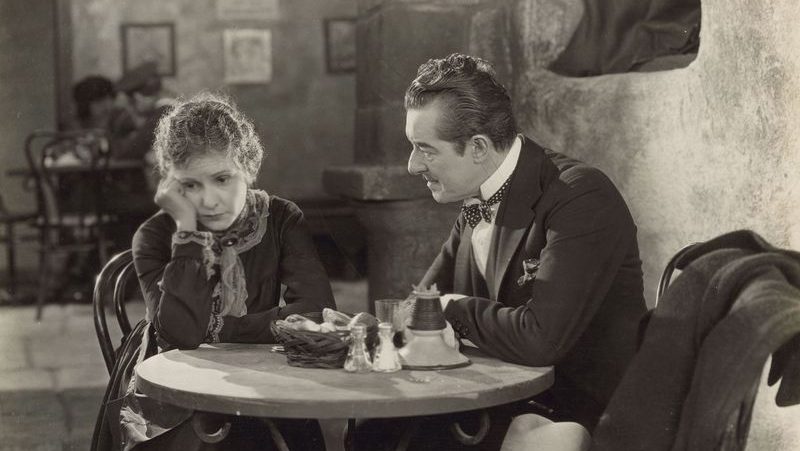LE GIORNATE DEL CINEMA MUTO, PORDENONE
NORMA TALMADGE, THE LADY. TUESDAY 4 OCTOBER CONTINUES THE RETROSPECTIVE DEVOTED TO THE AMERICAN STAR
The Ruritania retrospective presents two historic documentaries from 1912 featuring King Nicolas of Montenegro, one from Italy by Luca Comerio, Dalla Villa Reale di Rjeka (Montenegro), the other from France by Gaumont, Le Roi Nicolas de Monténégro.
The Italian title of Frank Borzage’s film The Lady (1925), being shown Tuesday 4 October, at 21.00 at the Teatro Verdi, is “Una vera signora”, which translates as “A Real Lady”, which perfectly describes Norma Talmadge, the subject of a major retrospective of this year’s Giornate. In the 1910s and 1920s she was a star assoluta, an actress praised for her versatility and elegance. Her acting style was subtle, avoiding overly accentuated gestures; instead, the expressiveness and mobility of her face allowed her to play different roles even within the same film, a talent which was much praised. Very popular in her time, her fame was totally eclipsed in the ensuing decades, probably because her films became unavailable. This situation is now being remedied, thanks to the fact that in the late 20th century a collection of films produced by Joseph M. Schenck, Talmadge’s producer and also her husband, were acquired by the Library of Congress, and a more systematic study of her work has begun. The Lady, like many of Talmadge’s films, was based on a successful Broadway stage play. It represents an exception in her career, however, because it did not meet with the usual popular success. In this instance, some critics were even fierce, and her fans were bewildered to see their favorite in the role of an old woman, telling the tragic story of her past to a sympathetic customer at her bar. We learn she is a former music hall singer, seduced and abandoned, forced to turn her baby over to the care of others, and she spends the rest of her life searching for her son. It was a plot that was too melodramatic and even a bit rough for respectable audiences, especially those in the heartland of America, because it was not difficult to guess her real occupation.
The day starts at 9.00, with a programme featuring two more Norma Talmadge films: the first is a short from 1914, during her period at Vitagraph; the second is a 1919 feature directed by Sidney A. Franklin, The Heart of Wetona, in which she plays a Native American.
Two films from the Ruritania retrospective open the afternoon programme at 14.30. Both are historic documentaries from 1912 featuring King Nicolas of Montenegro, one Italian, by Luca Comerio, Dalla Villa Reale di Rjeka (Montenegro), the other French, by Gaumont, Le Roi Nicolas de Monténégro. Nicknamed “the father-in-law of Europe”, having married 5 of his 9 daughters into royal families (Elena became the Queen of Italy), Nicolas was the first King of Montenegro, a country which corresponds perfectly to the mythical Ruritania, for the inaccessibility of its territory and the bellicose character of its inhabitants. Its image was very picturesque, including that of King Nicholas himself, who was always portrayed in national costume and armed.
A short film from the Slovenian Archive, Kralj Aleksander na Bledu (The Visit of King Alexander to Bled, 1928), by Veličan Bešter, a pioneering cameraman of Slovenian cinema, documents the visit of King Alexander I of Yugoslavia and his wife Queen Maria to the tourist locale of Lake Bled. We see panoramas of the lake and Seebach Castle (demolished in 1939 and later replaced by Villa Bled, the residence of Marshal Tito), and the arrival of the royal couple.
Completing the evening’s Ruritania programme is Hans Kungl. Höghet Shinglar (His Majesty the Barber, 1928), the last in a series of seven German-Swedish co-productions by the Isepa company at the end of the 1920s, which aimed to internationalize the Swedish film industry.
From the section “Rediscoveries and Restorations”, at 11.15, alongside a selection of Pathé-Baby 9.5mm shorts, is a feature that deserves to be singled out, Lāčplēsis (The Bear Slayer, 1930), inspired by an old Latvian legend, whose protagonist is a hero of extraordinary strength who comes to the defense of his people. Its director Aleksandrs Rusteiķis is considered one of the founders of Latvian cinema, and in this film he masterfully blends historical fact and legend.
An homage to Italian silent cinema, critical and passionate, lyrical and visionary at the same time, is a French-Italian production, Italia. Il fuoco, la cenere (2021), by Céline Gailleurd and Olivier Bohler, narrated by Isabella Rossellini, showing at 17.00 in the Teatro Verdi.
Tuesday 4 October at 13.00 is the second session of the Collegium that is also open to the public: its themes will be the beginnings of the cinema in Switzerland and the centenary of Pathé-Baby 9.5mm, the first format for home and amateur use.
Also on Tuesday, at 16.00 in the Ridotto of the Teatro Verdi, are more FilmFair book presentations by authors: L’oro di Atlantide. Il cinema muto italiano e le arti (Kaplan), edited by Céline Gailleurd, and Sguardi privati. Teorie e prassi del cinema amatoriale (Meltemi), with Paolo Caneppele.
The online festival programme, on MYmovies, at 21.00 presents two Ruritania films, Rupert of Hee Haw (1924), a comedy short by Percy Pembroke starring Stan Laurel, and the feature Hans Kungl. Höghet Shinglar (His Majesty the Barber, 1928) by Ragnar Hyltén-Cavallius.
The Giornate del Cinema Muto festival is realized thanks to the support of the Regione Autonoma Friuli Venezia Giulia, the Ministero della Cultura – Direzione Generale Cinema, the Comune di Pordenone, the Pordenone-Udine Chamber of Commerce, and the Fondazione Friuli.


 Italiano
Italiano
Recent Comments